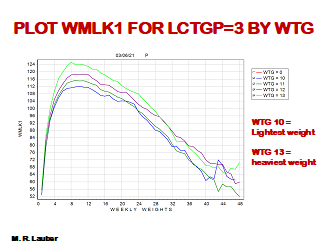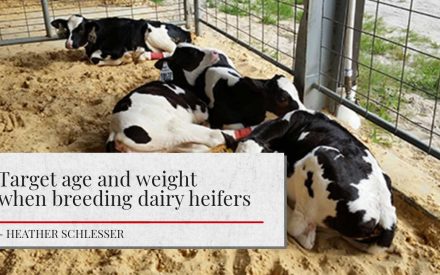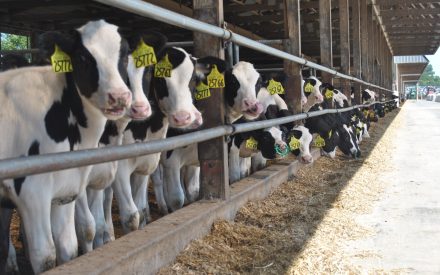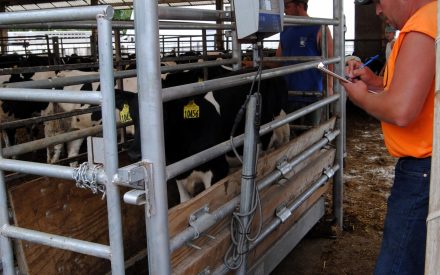Raising replacement heifers is a large investment for farmers to create the next generation for their herd. The cost of raising a replacement heifer on average is $2,500 with feed accounting for approximately 50% of the total rearing cost.1,2 The average age at first calving (AFC) has been decreasing in the United States because farmers are inseminating heifers at a younger age to calve sooner to decrease rearing costs.3 To achieve this early AFC, dairy heifers need to reach growth benchmarks to calve between 22 to 24 months of age to minimize time in the rearing period in a nonproductive state.4
Mature body weight (MBW) is defined as the weight of mature cows in the herd in their third or greater lactation. The body weight relative to MBW of the herd needs to be considered at breeding eligibility, pre-calving, and post-calving. Heifers at first breeding should be 55% MBW (825 lb, MBW = 1,500), 94% MBW pre-calving (1,410 lb, MBW = 1,500 lb), and 85% MBW post-calving (1,275 lb, MBW = 1,500 lb).4 While these benchmarks exist, few farmers know the MBW of their herd and are not weighing heifers to evaluate their growth program, which can impact herd milk production.
Weight versus age at first calving on milk production
Our objective was to determine the association between weight at 30 days in milk (DIM) versus AFC on milk production (lb/day) of Holsteins during their first lactation. We extracted data from Dairy Comp 305 files from a 6,692-cow Holstein herd that determined breeding eligibility mostly based on age with a preset voluntary wait period of 380 days. Only heifers with a normal gestation length of 250 to 300 days were included in the data set. The MBW of this herd was 1,510 lb and was determined by weighing 75 cows in their third and fourth lactation 30 to 40 DIM. First lactation cows were weighed at 30 DIM and grouped into quartiles based on weight relative to MBW.
The weight at 30 DIM and percent MBW for each quartile of first lactation cows was as follows: Q1: 1,126 lb, 75%; Q2: 1,220 lb, 81%; Q3: 1,255 lb, 86%; and Q4: 1,412 lb, 94%. The average AFC of these quartiles was 22 months of age, and only cows in Q3 and Q4 achieved 85% MBW post-calving. There was no interaction between AFC and weight at 30 DIM on first lactation milk production during weeks 4, 8, and 12. By contrast, there was a positive association with weight at 30 DIM and milk production. On average, the heaviest first lactation cows at 30 DIM (Q4) had 11 to 12 lb more milk per cow/day than the lightest weight first lactation cows (Q1) at weeks 4, 8, and 12 of lactation (Graph 1).5
Sire predicted transmitting ability (PTA) values provided additional insight into the association between genetic merit and performance. On average, Q4 cows had greater PTA value for milk than Q1 cows; however, Q4 cows were greater in stature and less feed efficient than Q1 cows. Focusing on fertility, Q4 cows on average had a lower PTA value for daughter pregnancy rate and a negative PTA value for heifer conception rate compared to Q1 cows. Differences in genetic merit are displayed in the pregnancies per AI (P/AI) as heifers at first service. As heifers, 71% of Q1 cows became pregnant at the first service compared to only 46% of Q4 cows.5 Since Q1 cows had greater genetic merit for fertility, they became pregnant sooner as heifers and shortened their growth period and decreased first lactation milk production compared to Q4 cows

Graph 1: Milk production (lb/day). Groups of bars represent weeks 4, 8, and 12 in first lactation. Bars represent the weight quartile at 30 DIM (Q1: lightest, 1,126 lb; Q2: second lightest weight, 1,220 lb; Q3: second heaviest, 1,292 lb; Q4: heaviest, 1,412 lb).
Do heifers ever catch up?
Weight at 30 DIM rather than AFC is positively associated with first lactation milk production, but does this impact milk production in subsequent lactations? Graph 2 displays the lactation curves of average weekly milk production of third lactation cows based on their weight at 30 DIM in their first lactation. The positive association with weight at 30 DIM and milk production is present in third lactation milk yield. Cows in their third lactation that calved in heavier and were at least 85% MBW had greater milk production. Thus, the impact of inadequate growth is additive, impacting milk production throughout the cow’s productive life.

Graph 2: Lactation curve of average weekly milk production (lb/week) of third lactation cows based on their weight at 30 DIM in their first lactation. Lines represent the weight quartile at 30 DIM (WTG10: lightest, blue; WTG11: second lightest weight, dark green; Q3: second heaviest, purple; Q4: heaviest, light green).
Heifer management considerations
Over the past 2 decades, reproductive performance has increased because of the adoption and implementation of fertility programs.6 This has allowed farmers to implement other reproductive technologies, such as sexed semen, which has increased heifer inventory. Raising extra replacement heifers is costly; therefore, it is critical to identify which heifers should be the next generation of cows, and which should be culled. Genomically testing heifers is a cost-effective strategy to determine genetically elite heifers more accurately and reliably. By focusing on quality over quantity of heifers, you can decrease rearing costs and more-intensely focus on managing heifers.
Once we identify the heifers we are keeping, then we can implement an aggressive heifer growth program. To evaluate heifer growth programs, the MBW of the herd needs to be determined by weighing third and fourth lactation cows. Further, heifers should be weighed at birth, weaning, 6 months, 12 months, pre-calving, and post-calving to determine average daily gain and to ensure heifers are achieving the target weight relative to MBW.
Breeding-age heifers should be inseminated quickly when they reach 55% MBW. An aggressive reproductive management strategy that inseminates all heifers when eligible is a 5-d CIDR-Synch protocol. This protocol tended to increase P/AI with sexed semen compared to once-daily detection of estrus.7 In addition, by using a 5-d CIDR-Synch protocol, this decreases the days on feed and the cost per pregnancy by $16.66 compared to once-daily detection of estrus.7
In conclusion, weight at 30 DIM rather than AFC is positively associated with milk production. Heifers can be managed to have a decreased AFC without sacrificing lifetime milk production by defining breeding eligibility based on weight relative to MBW and age.
Citations
- Akins, M.S. and M.A. Hagedorn. 2015. Heifer Management Blueprints. The Costs of Raising Dairy Replacements–2015 Updates. University of Wisconsin–Extension.
- Karszes, J. and L. Hill. 2020. Dairy Replacement Program: Cost & Analysis Summer 2019. Cornell University.
- Hutchison, J. L., P.M. VanRaden, D.J. Null, J.B. Cole, and D.M. Bickhartt. 2017. Genomic evaluation of age at first calving. Journal of Dairy Science 100(8): 6853–6861.
- Akins, M.S. 2016. Dairy Heifer Development and Nutrition Management. Veterinary Clinics of North America: Food Animal Practice 32(2): 303–317.
- Lauber, M.R., M.S. Akins, P.D. Carvalho, and P.M. Fricke. 2021. Weight at calving relative to mature body weight rather than age at first calving affects milk production in primiparous Holstein cows. Journal of Dairy Science 104(Suppl. 1): 270.
- Fricke, P.M. and M.C. Wiltbank. 2022. Symposium review: The implications of spontaneous versus synchronized ovulations on the reproductive performance of lactating dairy cows. Journal of Dairy Science 105(5): In press.
- Lauber, M.R., E.M. Cabrera, V.G. Santos, P.D. Carvalho, C. Maia, B. Carneiro, A. Valenza, V.E. Cabrera, J.J. Parrish, and P.M. Fricke. 2021. Comparison of reproductive management programs for submission of Holstein heifers for first insemination with conventional or sexed semen based on expression of estrus, pregnancy outcomes, and cost per pregnancy. Journal of Dairy Science 104(12): 12953–12967.
Download Article

 Edad y peso objetivo al criar vaquillas para productos lácteos
Edad y peso objetivo al criar vaquillas para productos lácteos Target age and weight when breeding dairy heifers
Target age and weight when breeding dairy heifers Heifer maturity matters
Heifer maturity matters You can’t manage what you don’t measure: Knowing and managing heifer weights
You can’t manage what you don’t measure: Knowing and managing heifer weights


